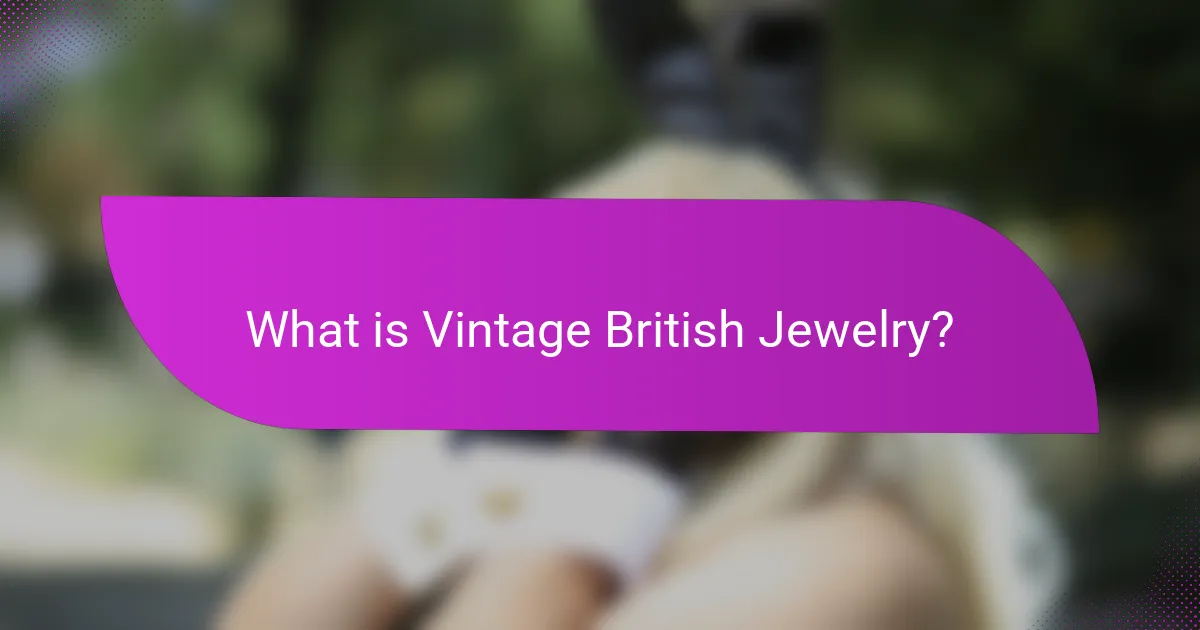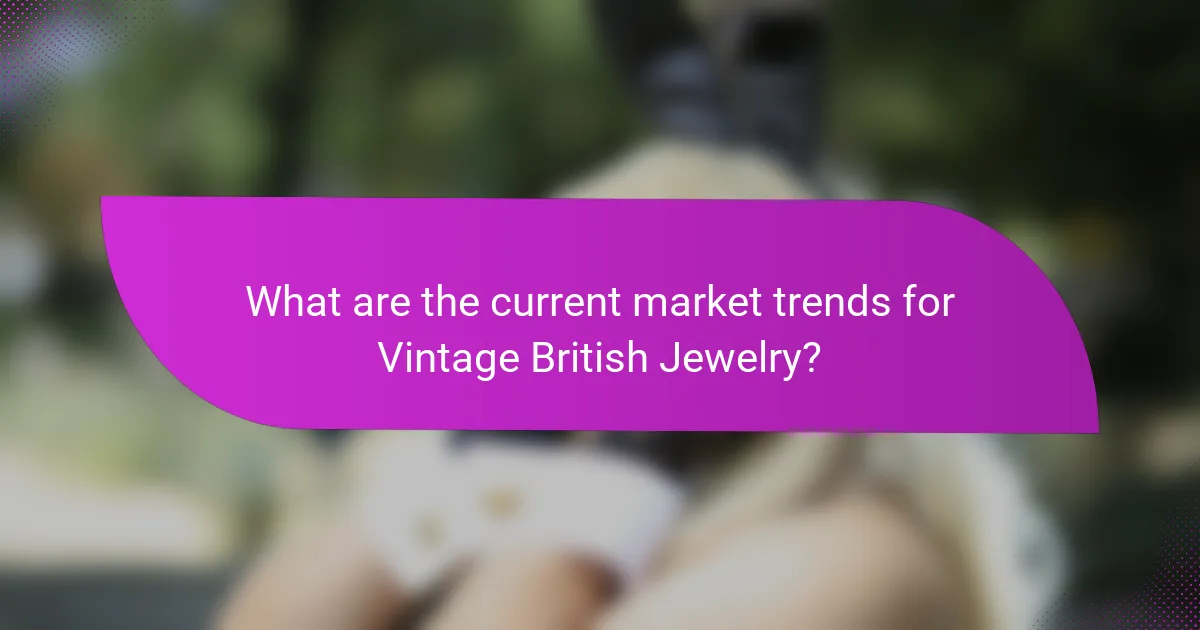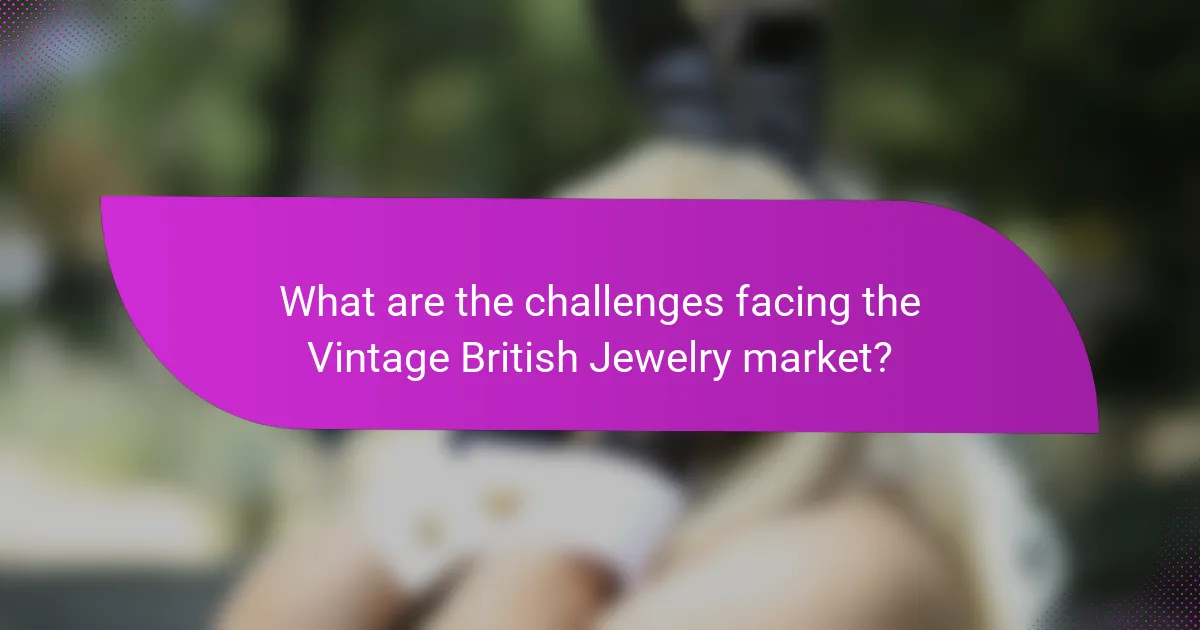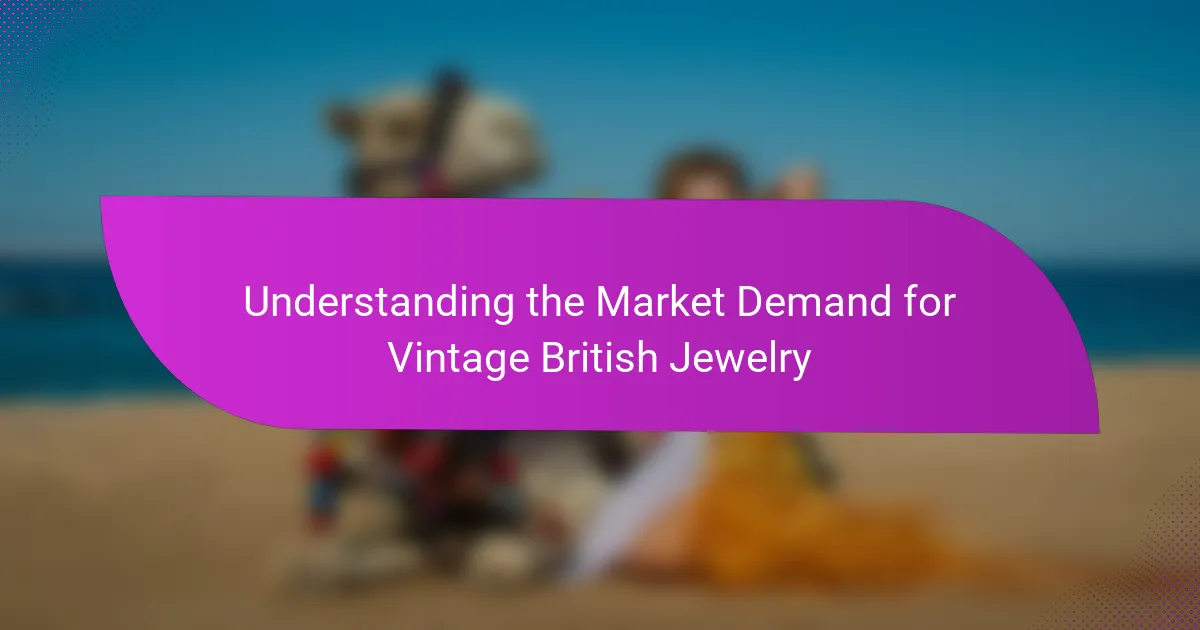Vintage British jewelry encompasses antique or second-hand jewelry created in Britain, primarily from the late 19th century to the mid-20th century. This jewelry is characterized by its unique craftsmanship and reflects historical design styles, including Art Deco, Victorian, and Edwardian influences, often made from gold, silver, and precious gemstones. The demand for Vintage British jewelry is rising, driven by a growing appreciation for sustainability, authenticity, and craftsmanship, alongside the impact of social media and celebrity endorsements. However, the market faces challenges such as authenticity verification, fluctuating demand due to fashion trends, and competition from modern jewelry brands. Collectors value these pieces not only for their aesthetic appeal but also for their investment potential, contributing to the evolving landscape of the Vintage British jewelry market.

What is Vintage British Jewelry?
Vintage British jewelry refers to antique or second-hand jewelry made in Britain, typically dating from the late 19th century to the mid-20th century. This type of jewelry often showcases distinctive craftsmanship and design styles, reflecting the historical and cultural influences of its time. Examples include Art Deco pieces, Victorian brooches, and Edwardian necklaces. The materials used often include gold, silver, and precious gemstones. Vintage British jewelry is sought after for its unique aesthetic and historical significance. Collectors value it for both its beauty and investment potential. The market for such jewelry has grown due to increased interest in sustainable fashion and nostalgia for past eras.
How did Vintage British Jewelry originate?
Vintage British Jewelry originated in the late 19th and early 20th centuries. This period saw a rise in craftsmanship and design influenced by various art movements. The Arts and Crafts Movement emphasized handmade techniques and natural motifs. The Victorian era also played a significant role, with intricate designs and sentimental pieces. Additionally, the influence of Art Nouveau introduced organic forms and flowing lines. These styles were shaped by social changes and technological advancements. The establishment of jewelry houses in Britain further contributed to the creation of unique pieces. Today, these historical influences are reflected in the market demand for vintage British jewelry.
What historical events influenced the design of Vintage British Jewelry?
The design of Vintage British Jewelry was significantly influenced by several historical events. The Victorian era (1837-1901) saw a surge in ornate jewelry, reflecting the period’s romanticism and industrial advancements. The Great Exhibition of 1851 showcased British craftsmanship and inspired jewelry design. The Art Nouveau movement (1890-1910) introduced organic shapes and natural motifs, impacting jewelry aesthetics. World War I (1914-1918) led to simpler designs due to resource scarcity. The post-war period (1920s) embraced Art Deco styles, emphasizing geometric patterns and luxury. The cultural shifts of the 1960s and 1970s also influenced designs, with a focus on individuality and bold colors. These events collectively shaped the evolution of Vintage British Jewelry.
What are the defining characteristics of Vintage British Jewelry?
Vintage British jewelry is characterized by its unique craftsmanship, historical significance, and distinctive styles. The craftsmanship often includes intricate details and high-quality materials, such as gold, silver, and precious gemstones. Historical significance is evident in the use of design motifs that reflect specific periods, like the Victorian or Edwardian eras. Distinctive styles often feature elaborate designs, including filigree, enameling, and unique gemstone settings. Additionally, vintage pieces often carry hallmarks that indicate authenticity and origin, which can enhance their value. The combination of these characteristics contributes to the appeal and demand for vintage British jewelry in the market.
Why is there a growing interest in Vintage British Jewelry?
There is a growing interest in Vintage British Jewelry due to its unique craftsmanship and historical significance. Vintage pieces often feature intricate designs that reflect the artistry of their time. Consumers are increasingly drawn to items with a story and character. The rise of sustainable fashion trends has also contributed to this interest. Vintage jewelry is seen as an eco-friendly choice compared to new mass-produced items. Additionally, collectors value the rarity of certain vintage pieces, making them sought-after investments. The internet has made it easier for buyers to access and appreciate these unique items. Social media platforms showcase vintage jewelry, enhancing its appeal among younger audiences.
What cultural factors contribute to the demand for Vintage British Jewelry?
The demand for Vintage British Jewelry is influenced by several cultural factors. Nostalgia plays a significant role, as consumers often seek items that evoke memories of past eras. The association with British heritage adds value, as these pieces are seen as representations of tradition and craftsmanship. Fashion trends also drive demand, with vintage styles gaining popularity in contemporary markets. Additionally, celebrity endorsements and social media exposure increase visibility and desirability. Collectibility is another factor, as unique pieces often become sought-after commodities. Lastly, sustainability concerns encourage consumers to choose vintage over new, aligning with eco-friendly values.
How does nostalgia play a role in the popularity of Vintage British Jewelry?
Nostalgia significantly contributes to the popularity of Vintage British Jewelry. This type of jewelry evokes fond memories of past eras, appealing to consumers’ emotions. Many people associate vintage pieces with personal stories or historical events. The craftsmanship and unique designs often reflect a bygone time, enhancing their sentimental value. Research shows that emotional connections can drive purchasing decisions. A study by the Journal of Consumer Research found that nostalgia can increase consumers’ willingness to pay. Thus, nostalgia not only shapes preferences but also elevates the perceived value of Vintage British Jewelry.

What are the current market trends for Vintage British Jewelry?
Current market trends for Vintage British Jewelry show a significant increase in demand. Collectors and consumers are increasingly valuing authenticity and craftsmanship. The rise of online marketplaces has made vintage pieces more accessible. Social media platforms are influencing trends by showcasing unique items. Sustainability concerns are driving interest in vintage over new jewelry. Prices for rare pieces have been steadily increasing, reflecting their desirability. The influence of celebrity endorsements has also boosted market visibility. Overall, the market for Vintage British Jewelry is thriving and evolving.
How is Vintage British Jewelry valued in today’s market?
Vintage British jewelry is valued based on its historical significance, craftsmanship, and condition. The rarity of specific pieces greatly influences their market price. Provenance, or the jewelry’s history of ownership, also plays a crucial role in valuation. Additionally, current market trends and collector demand can affect prices significantly. For example, pieces from renowned designers like Fabergé or Cartier fetch higher prices. The valuation process often involves appraisals by experts who assess these attributes. Recent auction results indicate that high-quality vintage British jewelry can appreciate significantly over time, sometimes doubling in value within a few years.
What factors affect the pricing of Vintage British Jewelry?
The pricing of Vintage British Jewelry is affected by several key factors. The age of the jewelry significantly impacts its value; older pieces often command higher prices. The rarity of the item also plays a crucial role; unique designs or limited production increases desirability. The condition of the jewelry is vital; well-preserved items fetch better prices than those in poor condition. The provenance, or history of ownership, can enhance value; pieces with notable previous owners are more sought after. Additionally, market trends influence pricing; current fashion and collector interest can drive prices up or down. Finally, the materials used, such as gold, silver, or precious gemstones, directly affect the cost.
What are the most sought-after styles and periods in Vintage British Jewelry?
The most sought-after styles and periods in Vintage British Jewelry include the Georgian, Victorian, Edwardian, and Art Deco eras. The Georgian period (1714-1830) is known for its intricate designs and use of natural motifs. Victorian jewelry (1837-1901) reflects sentimental themes and diverse materials. The Edwardian era (1901-1910) is characterized by delicate lace-like designs and platinum settings. Art Deco (1920s-1930s) features bold geometric shapes and vibrant colors. Collectors often seek pieces from these periods due to their historical significance and craftsmanship. The popularity of these styles is supported by auction results and collector interest in vintage jewelry markets.
Who are the primary buyers of Vintage British Jewelry?
The primary buyers of Vintage British Jewelry are collectors, fashion enthusiasts, and individuals seeking unique gifts. Collectors are often motivated by the historical significance and craftsmanship of the pieces. Fashion enthusiasts purchase vintage jewelry to complement their personal style. Individuals seeking unique gifts value the distinctiveness of vintage items. Wealthy buyers also play a significant role in this market, often purchasing high-end pieces at auctions. According to a report by the Antique Jewelry & Art Conference, the demand for vintage jewelry has increased by 30% in the last five years. This trend highlights the growing interest in unique and historically rich adornments.
What demographics are most interested in Vintage British Jewelry?
Women aged 25 to 55 are the primary demographic interested in Vintage British Jewelry. This group often seeks unique, high-quality pieces that reflect personal style. Additionally, collectors and vintage enthusiasts, regardless of gender, show significant interest. Many individuals in this demographic appreciate the historical context and craftsmanship of vintage items. According to market research, this interest is driven by a desire for sustainable fashion choices. Furthermore, affluent consumers tend to invest in vintage jewelry as a status symbol. The growing popularity of vintage trends on social media platforms also influences younger audiences.
How do collectors influence the market for Vintage British Jewelry?
Collectors significantly influence the market for Vintage British Jewelry by driving demand and setting prices. Their interest often leads to increased awareness of specific pieces and styles. This heightened attention can create scarcity, making certain items more desirable. As collectors compete for rare pieces, prices can rise substantially. Historical auction data shows that pieces with collector provenance often sell for higher amounts. Additionally, collectors can shape trends within the market, influencing what is considered valuable. Their preferences can lead to a shift in focus towards particular eras or designers. Overall, the actions and interests of collectors play a crucial role in determining market dynamics for Vintage British Jewelry.

What are the challenges facing the Vintage British Jewelry market?
The Vintage British Jewelry market faces several challenges. One significant challenge is the authenticity verification of pieces. Counterfeit items can mislead buyers and damage trust. Another challenge is fluctuating demand influenced by fashion trends. Economic downturns can also reduce consumer spending on luxury items. Additionally, the aging demographic of collectors may affect market sustainability. Limited availability of high-quality vintage pieces can drive prices up, making them less accessible. Lastly, competition from modern jewelry brands poses a threat to market share.
How does authenticity impact the market for Vintage British Jewelry?
Authenticity significantly impacts the market for Vintage British Jewelry. Authentic pieces command higher prices due to their historical value and craftsmanship. Collectors prioritize genuine items, which enhances demand. The presence of certificates of authenticity can further increase buyer confidence. Conversely, replicas or non-authentic items can diminish market value. The market for Vintage British Jewelry relies heavily on trust and provenance. Provenance, or the history of ownership, plays a crucial role in establishing authenticity. A strong provenance can elevate the desirability of a piece.
What are the common issues with counterfeit Vintage British Jewelry?
Counterfeit Vintage British Jewelry often faces issues related to authenticity and quality. Many pieces are poorly crafted and do not meet the standards of genuine vintage jewelry. Authentic vintage jewelry typically features specific hallmarks and craftsmanship that counterfeits lack.
Common problems include incorrect metal compositions, such as using base metals instead of gold or silver. Counterfeit items may also have inferior gemstones that do not match the historical specifications. Additionally, the design details may differ significantly from authentic pieces, making them easily identifiable by experts.
The market for counterfeit jewelry has grown due to increased demand for vintage items. According to the British Antique Dealers’ Association, the rise in online sales has made it easier for counterfeiters to reach consumers. This has led to a need for better education on identifying genuine vintage jewelry.
How can buyers ensure they are purchasing genuine Vintage British Jewelry?
Buyers can ensure they are purchasing genuine Vintage British Jewelry by verifying its provenance and authenticity. They should request documentation or certificates of authenticity from reputable sellers. Examining the jewelry’s hallmarks is crucial, as British pieces typically bear specific marks indicating the maker and date. Researching the seller’s reputation and customer reviews can provide insight into their credibility. Consulting with experts or appraisers can help in confirming authenticity. Buyers should also familiarize themselves with common characteristics of genuine vintage pieces, such as craftsmanship and materials used. Understanding the historical context of the jewelry can aid in identifying fakes. These steps collectively enhance the likelihood of acquiring authentic Vintage British Jewelry.
What strategies can sellers use to effectively market Vintage British Jewelry?
Sellers can effectively market Vintage British Jewelry by utilizing online platforms and social media. Establishing an online presence through websites and e-commerce platforms enhances visibility. Social media channels like Instagram and Pinterest are ideal for showcasing jewelry designs. High-quality images and engaging content attract potential buyers.
Storytelling about the jewelry’s history adds emotional value. Sellers should highlight unique attributes of each piece, such as craftsmanship and provenance. Collaborating with influencers can expand reach to targeted audiences. Hosting virtual events or webinars educates consumers about vintage jewelry.
Offering authentic certificates of appraisal builds trust with buyers. Utilizing search engine optimization (SEO) techniques increases online discoverability. According to a report by Statista, online jewelry sales have been growing steadily, indicating a strong market potential.
How can online platforms enhance the visibility of Vintage British Jewelry?
Online platforms can enhance the visibility of Vintage British Jewelry through targeted marketing strategies. These strategies include search engine optimization (SEO) to improve online rankings. By using relevant keywords, sellers can attract more traffic to their listings. Social media marketing also plays a crucial role. Platforms like Instagram and Pinterest allow for visual storytelling, showcasing the unique designs and history of the jewelry.
Utilizing influencer partnerships can further amplify reach. Influencers can introduce Vintage British Jewelry to their followers, creating a wider audience. Online marketplaces specifically for vintage items can also increase exposure. These platforms often attract niche customers interested in unique jewelry pieces.
High-quality photography is essential for online listings. Clear, detailed images highlight the craftsmanship and appeal of the jewelry. Providing detailed descriptions with historical context adds value for potential buyers. These practices collectively enhance the online presence of Vintage British Jewelry, making it more accessible to consumers.
What marketing techniques resonate with potential buyers of Vintage British Jewelry?
Content marketing techniques resonate with potential buyers of Vintage British Jewelry. Storytelling about the history and craftsmanship of the pieces attracts interest. Social media platforms showcase visual appeal, engaging potential buyers effectively. Influencer partnerships enhance credibility and reach within niche markets. Email marketing campaigns offer personalized recommendations and exclusive deals. Online marketplaces provide a broader audience, facilitating easier access to vintage collections. SEO strategies improve visibility in search results, connecting buyers with desired items. Customer testimonials build trust and validate purchasing decisions.
What tips should buyers consider when purchasing Vintage British Jewelry?
Buyers should consider authenticity, condition, and provenance when purchasing Vintage British Jewelry. Authentic pieces often come with hallmarks indicating origin and metal purity. Inspecting the condition is crucial; look for signs of wear or damage that could affect value. Provenance, or the history of ownership, adds to the piece’s significance. Research market trends to understand pricing and demand. Familiarity with reputable dealers ensures a trustworthy purchase. Additionally, consider the style and era of the jewelry, as popularity can vary. These factors collectively help buyers make informed decisions in the Vintage British Jewelry market.
Vintage British Jewelry is defined as antique or second-hand jewelry made in Britain, primarily from the late 19th century to the mid-20th century, characterized by unique craftsmanship and historical significance. The article explores the origins, defining characteristics, and cultural factors contributing to the growing interest in this jewelry, alongside current market trends and valuation methods. It addresses challenges such as authenticity verification and counterfeit issues while providing strategies for buyers to ensure genuine purchases. Additionally, the role of collectors and demographics interested in vintage jewelry is examined, highlighting the impact on market dynamics.
